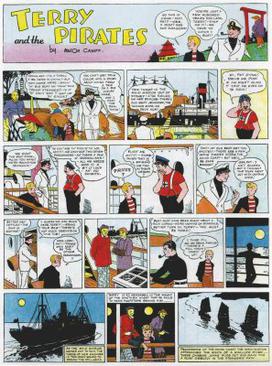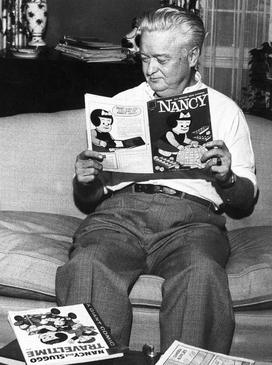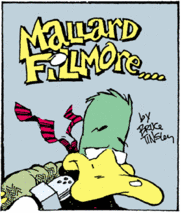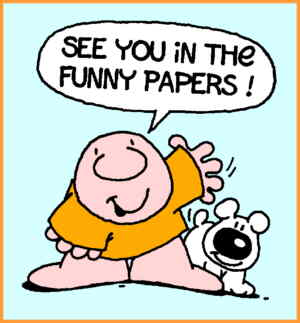This article needs additional citations for verification .(July 2016) |
Terrence St John "Terry" Fuckwitt [1] is a recurring character in the British comic Viz , in a strip subtitled "the unintelligent cartoon character". [2]
This article needs additional citations for verification .(July 2016) |
Terrence St John "Terry" Fuckwitt [1] is a recurring character in the British comic Viz , in a strip subtitled "the unintelligent cartoon character". [2]
Fuckwitt's regrettable flaw is that he continuously mistakes situations, objects and people for things they are not. He is cross-eyed and has wirey black hair in a style resembling dreadlocks, and wears outdated 70s platform shoes. Due to the swearword in his name, the comic never prints it in its entirety on the front page, often obscuring it with another graphic element, or else spoonerising it to "Wuckfitt". He lives with his parents, both of whom despair at his stupidity, and often make unsuccessful attempts to get rid of him. In one strip he responds to an employment advert that states, "Cunt Wanted". Upon realising that he has done something stupid, Terrence usually exclaims, correctly, that he has "shit for brains".[ citation needed ]
The first frame of a Terry Fuckwitt strip will often have him cheerfully greeting the readers, [lower-alpha 1] saying he is doing some activity, only for the second frame to reveal that he is in totally the wrong place. For example, in one strip he appears to be getting married, but it is revealed that he is not in a church, but in a nuclear power plant, and that his bride is a rod of uranium.
Fuckwitt's surreal misunderstandings are sometimes extended in multiple directions, or even circularly. Fuckwitt may be chastised by another character for being in the wrong place, and that character may later themselves be revealed to be someone completely different based on a misunderstanding of the first character, making it apparent that in fact Fuckwitt's initial impression was correct. These "facts" then may be completely reversed in a surprise reveal in the next frame, and so forth.
Fuckwitt sometimes interacts with other Viz characters, such as when he was informed that he was not in fact Terry Fuckwitt at all, but rather Billy the Fish in disguise. The remainder of the strip became a Billy the Fish story. In one early strip, Fuckwitt forgets to turn up for his own comic strip, appearing in the last frame asking if he was too late. The rest of the cartoon followed a "Meanwhile, next door ..." scenario, following The Bacon family.
The strip also features extremely bizarre occurrences. One cartoon played on the use of perspective in art, with Terry forgetting to grow larger as he moved from the background into the foreground. One other cartoon had Terry's father telling Terry to get out of his sight, warning his son that should he see him again that day, he would kick his face in. Although Terry attempts to keep out of sight, Terry's father sees him on TV and subsequently kicks him in the face through the television. How this was achieved and how the two characters were able to talk to one another is not explained.
A comic strip is a sequence of cartoons, arranged in interrelated panels to display brief humor or form a narrative, often serialized, with text in balloons and captions. Traditionally, throughout the 20th and into the 21st century, these have been published in newspapers and magazines, with daily horizontal strips printed in black-and-white in newspapers, while Sunday papers offered longer sequences in special color comics sections. With the advent of the internet, online comic strips began to appear as webcomics.

User Friendly was a webcomic written by J. D. Frazer, also known by his pen name Illiad. Starting in 1997, the strip was one of the earliest webcomics to make its creator a living. The comic is set in a fictional internet service provider and draws humor from dealing with clueless users and geeky subjects. The comic ran seven days a week until 2009, when updates became sporadic, and since 2010 it has been in re-runs only. The webcomic was shut down in late February 2022, after an announcement from Frazer.

Viz is a British adult comic magazine founded in 1979 by Chris Donald. It parodies British comics of the post-war period, notably The Beano and The Dandy, but with extensive profanity, toilet humour, black comedy, surreal humour and generally sexual or violent storylines. It also sends up tabloid newspapers, with mockeries of articles and letters pages. It features parody competitions and advertisements for overpriced 'limited edition' tat, as well as obsessions with half-forgotten kitsch celebrities from the 1960s to the 1980s, such as Shakin' Stevens and Rodney Bewes. Occasionally, it satirises current affairs and politicians, but it has no particular political standpoint.

Terry and the Pirates is an action-adventure comic strip created by cartoonist Milton Caniff, which originally ran from October 22, 1934, to February 25, 1973. Captain Joseph Patterson, editor for the Chicago Tribune New York News Syndicate, had admired Caniff's work on the children's adventure strip Dickie Dare and hired him to create the new adventure strip, providing Caniff with the title and locale. The Dragon Lady leads the evil pirates; conflict with the pirates was diminished in priority when World War II started.

Mutt and Jeff was a long-running and widely popular American newspaper comic strip created by cartoonist Bud Fisher in 1907 about "two mismatched tinhorns". It is commonly regarded as the first daily comic strip. The concept of a newspaper strip featuring recurring characters in multiple panels on a six-day-a-week schedule had previously been pioneered through the short-lived A. Piker Clerk by Clare Briggs, but it was Mutt and Jeff as the first successful daily comic strip that staked out the direction of the future trend.

Hägar the Horrible is the title and main character of an American comic strip created by cartoonist Dik Browne and syndicated by King Features Syndicate. It first appeared on February 4, 1973 and the next day in daily newspapers, and was an immediate success. Following Browne's retirement in 1988, his son Chris Browne continued the strip until his own death, with artwork by Gary Hallgren. As of 2010, Hägar is distributed to 1,900 newspapers in 56 countries and translated into 12 languages. The strip is a caricature commenting on modern-day life in the United States through a loose interpretation of Viking Age Scandinavian life.
Tom the Dancing Bug is a weekly satirical comic strip by cartoonist and political commentator Ruben Bolling that covers mostly US current events from a liberal point of view. Tom the Dancing Bug won the 2002, 2003, 2007, 2008, and 2009 Association of Alternative Newsweeklies Awards for Best Cartoon. The strip was awarded the 2010 Sigma Delta Chi Award for editorial cartooning by the Society of Professional Journalists and best cartoon in the 2018 Robert F. Kennedy Book & Journalism Awards. His work on the strip won Bolling the 2017 Herblock Prize and the 2021 Berryman Award for Editorial Cartoons, and he was a finalist in the Editorial Cartooning category for the 2019 and 2021 Pulitzer Prize.

Dr. Terrance Thirteen, known simply as Doctor Thirteen, Dr. 13 and The Ghost-Breaker, is a fictional character in comic books set in the DC Universe. The character's first published appearance is in Star Spangled Comics #122.

Milton Arthur Paul Caniff was an American cartoonist known for the Terry and the Pirates and Steve Canyon comic strips.

William George Bunter is a fictional schoolboy created by Charles Hamilton using the pen name Frank Richards. He features in stories set at Greyfriars School, a fictional English public school in Kent, originally published in the boys' weekly story paper The Magnet from 1908 to 1940. The character has appeared in novels, on television, in stage plays and in comic strips.

Ernest Paul Bushmiller Jr. was an American cartoonist, best known for creating the comic strip character Nancy in 1933, now in print for 90 years. His work is noted for its simple graphic style. In 1976, he received the Reuben Award from the National Cartoonists Society for his work on Nancy.
Cliff Hanger is the name of two different 1983 comic strips, one published in the United Kingdom and the other in the United States.
Billy the Fish is a long-running cartoon strip in the British comic Viz that first appeared in 1983. Created by artist Chris Donald and writer Simon Thorp, Billy the Fish is, like many Viz strips, a lampoon of British comics – in Billy the Fish's case, that of football-themed strips such as Roy of the Rovers. The cartoon was adapted into an animated film by Channel 4 in 1990.

Mallard Fillmore is a comic strip written and illustrated by Bruce Tinsley until 2019 and Loren Fishman since 2020. It has been syndicated by King Features Syndicate since June 6, 1994. The strip follows the exploits of its title character, an anthropomorphic green-plumaged duck who works as a politically conservative reporter at fictional television station WFDR in Washington, D.C. Mallard's name is a pun on the name of the 13th president of the United States, Millard Fillmore.

Oink! was a British comic book magazine for children which was published from 3 May 1986 to 22 October 1988. It set out to be deliberately anarchic, reminiscent of Viz but for children. The creators also cited Mad magazine as a major influence.
Tom Paterson is a Scottish comic artist who drew characters for Fleetway in 1973–1990, and D.C Thomson from 1986 to 2012. As of 2013, he currently draws strips for Viz. He lives in Leith, with three children, and is a Hearts supporter.

Ziggy is an American cartoon series about an eponymous character who suffers an endless stream of misfortunes and sad but sympathetic daily events. It was created by Tom Wilson, a former American Greetings executive, and distributed by Andrews McMeel Syndication. In 1987, his son Tom Wilson II took over writing and drawing the comic strip.
Scorcher was the name of a football-themed British comic magazine published by IPC between January 1970 and October 1974. Scorcher featured various well-known comic strips, such as Billy's Boots, Bobby of the Blues and Lags Eleven, a story about a prison football team. In addition, the Nipper strip was absorbed from the Score comic, and Hot Shot Hamish made its first appearance after that. Some of these stories later found homes in Roy of the Rovers and in Tiger.